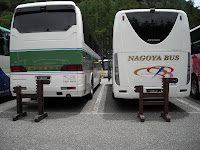 Souya Misaki is the northern most place in the whole of Japan. And somewhere south, about 45min by bus, is the JR Wakkanai Station, the northern most station on the JR line. Ideally, I would love to take one of the sleeper train overnight from Ueno to Sapporo. Arriving in the morning and make my up north. But that's 'ideally'. JR slap about 9000Yen surcharge for the sleeper Cassiopia and Hokutosei trains even with the JR Japan Rail Pass. So, this is out. The alternative is to take the earliest possible train out of Ueno to Hokkaido. "Earliest possible" meant one leaving Tokyo after 7am since it would take me about an hour out of Minami-NagareYama, and the first train out is after 5:30pm. And experience from the Kamikochi trip tells me it is possible for the first train to start late.
Souya Misaki is the northern most place in the whole of Japan. And somewhere south, about 45min by bus, is the JR Wakkanai Station, the northern most station on the JR line. Ideally, I would love to take one of the sleeper train overnight from Ueno to Sapporo. Arriving in the morning and make my up north. But that's 'ideally'. JR slap about 9000Yen surcharge for the sleeper Cassiopia and Hokutosei trains even with the JR Japan Rail Pass. So, this is out. The alternative is to take the earliest possible train out of Ueno to Hokkaido. "Earliest possible" meant one leaving Tokyo after 7am since it would take me about an hour out of Minami-NagareYama, and the first train out is after 5:30pm. And experience from the Kamikochi trip tells me it is possible for the first train to start late.I would also like to arrive in Wakkanai station on the same day, but I found no sub-5000Yen hotel there, so have to settle for one in Minami-Wakkanai station, one station south of the Wakkanai station.
So, here's the road north:
Leave on the last train from Minami-Nagareyama headed for Tokyo.

Would have missed this if I have doubled back to check I have locked my door.
Head to Akihabara and "check in" to a Manga Kissa place.
 At 1080Yen for manga, internet and free flow of coffee and other drinks, this is a good way to spend the night before the first train on the Yamanote line.
At 1080Yen for manga, internet and free flow of coffee and other drinks, this is a good way to spend the night before the first train on the Yamanote line.Eight cups of coffee later,
 its time to head out to a bright cool morning, and back up on the Yamanote line to Tokyo.
its time to head out to a bright cool morning, and back up on the Yamanote line to Tokyo.This being the first day of a long weekend, the Tokyo station is busy with activities.
 Some travellers were with their full hiking gear. The 6:00 train from Tokyo will run all the way to the end of the Shinkashen line in Hachinohe.
Some travellers were with their full hiking gear. The 6:00 train from Tokyo will run all the way to the end of the Shinkashen line in Hachinohe.After Hachinohe,
 it's another train across the straits between Honsho and Hokkaido in a tunnel under the sea.
it's another train across the straits between Honsho and Hokkaido in a tunnel under the sea.After a short stop in Hakodate, it is onwards toward Sapporro.

From Sapporro, it is a Rapid train up north.
 By the time I reached Minami-Wakkanai, it was slightly before 11pm. I am now thousand over km from Tokyo, and would have been on the road for almost 17 hrs.
By the time I reached Minami-Wakkanai, it was slightly before 11pm. I am now thousand over km from Tokyo, and would have been on the road for almost 17 hrs.Stay at the Chikou Hotel for the night.
 I like the sound of it. I think all Fragrance and Hotel 81 establishment in the Geylang area should be renamed Chikou Hotels.
I like the sound of it. I think all Fragrance and Hotel 81 establishment in the Geylang area should be renamed Chikou Hotels.











































